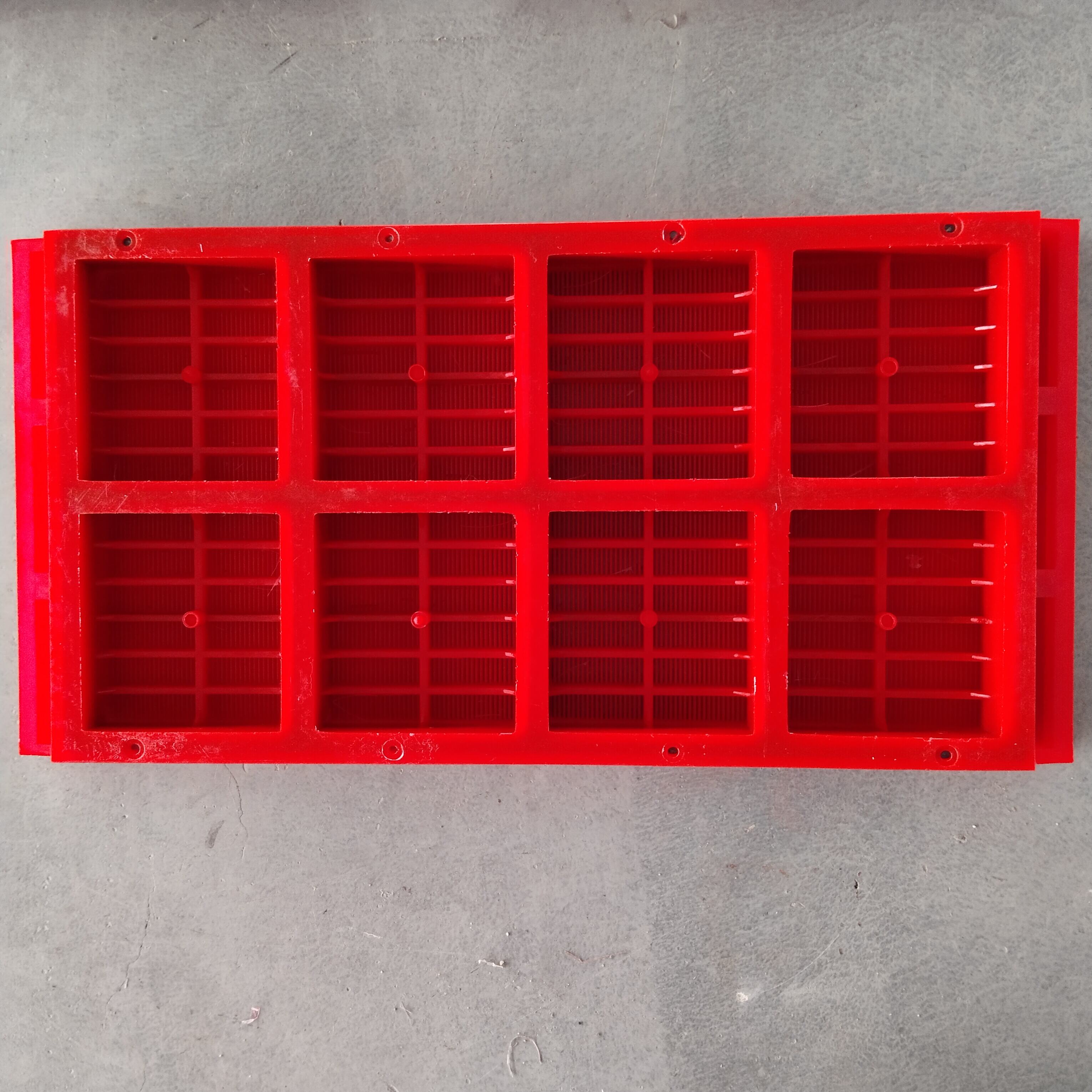उत्पाद गुणवत्ता पर प्रभाव डालने वाले पॉलीयूरिथेन स्क्रीन मीडिया के मुख्य गुण
मांगों के कठिन अनुप्रयोगों में पहन संतुलन और लंबी उपयोगकाल
पॉलियुरेथेन से बने स्क्रीन मीडिया अपनी अत्यधिक टिकाऊपन के कारण अलग दिखाई देते हैं, क्योंकि ये अन्य विकल्पों की तुलना में जल्दी घिसते नहीं हैं। विभिन्न क्षेत्र परीक्षणों के अनुसार, ये स्क्रीन सामान्य धातु या सिंथेटिक विकल्पों की तुलना में लगभग 7 से 9 गुना अधिक समय तक चलती हैं। इसका अर्थ है कि अधिक व्यस्त संचालन के दौरान भी कम प्रतिस्थापन की आवश्यकता होती है और मरम्मत में कम समय व्यतीत होता है। यह सामग्री कठोर व्यवहार का सामना करने में भी सक्षम है। खनन दल इसे अच्छी तरह से जानते हैं, क्योंकि उनके उपकरण प्रतिदिन पत्थरों और मलबे से टकराते रहते हैं। निर्माण स्थल भी लगातार कंपन और घर्षण सामग्री के साथ समान चुनौतियों का सामना करते हैं। जब स्क्रीन वास्तव में लंबे समय तक बनी रहती हैं, तो कई तरीकों से धन की बचत होती है। न केवल व्यवसायों को अक्सर नई स्क्रीन खरीदने से बचाया जाता है, बल्कि स्थापना अवधि के दौरान होने वाली उत्पादकता की हानि पर भी कमी आती है। कुछ कंपनियां वार्षिक हजारों रुपयों की बचत की सूचना देती हैं, केवल पॉलियुरेथेन स्क्रीन पर स्विच करके।
तिरछी खुली छेद : स्थिर आउटपुट के लिए ब्लाइंडिंग को कम करना
पॉलीयूरिथेन स्क्रीनों पर टेपर्ड ओपनिंग्स लगभग वही हैं जो उन्हें ब्लाइंडिंग समस्याओं के खिलाफ लड़ने में इतनी प्रभावी बनाती हैं। जब सामग्री इन स्क्रीनों से होकर गुजरती है, तो विशेष आकार छोटे कणों को फंसने और सतह को अवरुद्ध करने से रोकता है। इसका मतलब है कि सामग्री बिना रुकावट के सुचारु रूप से बहती रहती है, जिससे निर्माताओं को अधिक पूर्वानुमेय उत्पादन दर मिलती है। उन कंपनियों के लिए जो दिन-रात प्रसंस्करण लाइनों को संचालित कर रही हैं, ऐसी भरोसेमंदी काफी महत्व रखती है। कुछ वास्तविक क्षेत्र परीक्षणों से पता चला है कि जब संयंत्र इन टेपर्ड डिज़ाइनों में परिवर्तन करते हैं, तो अवरुद्ध स्क्रीनों के कारण होने वाले बंद होने में ध्यान देने योग्य कमी दिखाई देती है। परिणाम? समस्याओं के समाधान में कम समय बर्बाद होता है और अधिक उत्पादों को तेज़ी से प्रणाली से होकर ले जाया जाता है।
इलास्टिक मेमोरी: तनाव के तहत खोल की अभिव्यक्ति का बनाए रखना
पुरानी आकृति में वापस आने की अच्छी क्षमता होने के कारण पॉलियुरेथेन स्क्रीन मीडिया को दबाए जाने के बाद भी वे अपने मूल आकार में लौट आते हैं और छेदों को बनाए रखते हैं, भले ही उनका आकार बदल जाए। यह लोच उच्च ऑपरेशन तनाव के दौरान भी अच्छे स्क्रीनिंग परिणामों को बनाए रखने के लिए बहुत महत्वपूर्ण है, जिससे इन स्क्रीनों का जीवन लंबा होता है और वे बेहतर ढंग से काम करते हैं। वास्तविक संयंत्र संचालन में हमने देखा है कि आकार को बनाए रखने वाले स्क्रीनों में खराबी कम होती है और वे महीनों तक लगातार प्रदर्शन जारी रखते हैं। आकार को बनाए रखने की क्षमता के कारण अधिकांश समय सही ढंग से सामग्री को अलग करते हैं, जिससे उत्पादन संख्या में सुधार होता है और समग्र रूप से उत्पाद की गुणवत्ता में लगातार सुधार होता है।
पारस्परिक प्रदर्शन ट्रेडिशनल स्क्रीनिंग सामग्री के खिलाफ
पॉलीयूरिथेन बजाय विराजमान तार: 7-9 गुना लंबी सेवा जीवन
जब बात उनके स्थायित्व की होती है, तो पॉलीयूरिथेन स्क्रीनें तारों से बनी स्क्रीनों को काफी बड़ी सीमा तक पीछे छोड़ देती हैं, जिन्हें बदलने की आवश्यकता अक्सर लगभग नौ गुना अधिक बार होती है। लेकिन वास्तविक कंपनियों के लिए इसका जो मतलब है, वह केवल तकनीकी विनिर्देशों से अधिक महत्वपूर्ण है। कंपनियां काफी पैसे की बचत करती हैं जब वे स्क्रीन बदल देती हैं, क्योंकि उन्हें बार-बार नई स्क्रीनें खरीदने की आवश्यकता नहीं होती। कुछ कारखानों ने बदलाव के बाद बदलने की लागत में 70% से अधिक की कमी की सूचना दी है। विभिन्न उद्योगों में किए गए वास्तविक परीक्षण भी इसकी पुष्टि करते हैं। कंपनियां केवल नकद की बचत ही नहीं करतीं, बल्कि श्रमिकों को रखरखाव से जुड़े मुद्दों से निपटने में भी कम समय बिताना पड़ता है, क्योंकि पॉलीयूरिथेन काफी लंबे समय तक चलता है। बजट और उत्पादन कार्यक्रमों पर नज़र रखने वाले संयंत्र प्रबंधकों के लिए, इस तरह की विश्वसनीयता सब कुछ है।
ध्वनि कम करने के फायदे मेटल स्क्रीन सरफेस की तुलना में
पॉलीयूरेथेन सामग्री खास तौर पर उल्लेखनीय है क्योंकि यह शोर को काफी कम कर देती है, जिसके कारण अक्सर पुरानी धातु की स्क्रीनों की तुलना में यह बेहतर होती है। जहां तक शोर करने वाली मशीनों के संबंध में कारखानों और संयंत्रों का सवाल है, अतिरिक्त शोर को दूर करना बहुत मायने रखता है। जब कोई व्यवसाय स्थानीय शोर कानूनों का पालन करता है, तो वह न केवल नियमों के अनुपालन की स्थिति में रहता है बल्कि ऐसे कार्यस्थलों को भी बनाता है जो कानों को खराब न करने वाले हों। कुछ अध्ययनों में वास्तविक परिणामों की ओर भी संकेत किया गया है। जिन संयंत्रों ने पॉलीयूरेथेन स्क्रीन मीडिया पर स्विच किया, उन्होंने अपने आसपास के पड़ोस के लगातार औद्योगिक शोर के बारे में शिकायतों में काफी कमी बताई है। यह केवल सैद्धांतिक बात नहीं है, यह अलग-अलग विनिर्माण क्षेत्रों में व्यावहारिक रूप से काम करती है।
पॉलीएस्टर फिल्टर स्क्रीन की तुलना में आर्द्रता प्रतिरोध
नमी को संभालने के मामले में, पॉलियुरेथेन स्क्रीनें अपने पॉलिएस्टर वाले समकक्षों की तुलना में वास्तव में अलग खड़ी होती हैं, खासकर जब आप नम वातावरण में काम कर रहे हों। ये स्क्रीन नमी के संपर्क में आने पर आसानी से खराब नहीं होतीं, जिसका मतलब है कि ये बाजार में अन्य सामग्रियों की तुलना में काफी लंबे समय तक चलती हैं। निर्माण संयंत्रों ने पॉलियुरेथेन स्क्रीनों में स्थानांतरित होने के बाद काफी सुधार की सूचना दी है, जिसमें कई ने बारिश के मौसम या तटीय क्षेत्रों में नमी के स्तर के कारण होने वाली समस्याओं में काफी कमी दर्ज की है। इसे इतना मूल्यवान बनाने वाली बात क्या है? अच्छा, ज्यादा समय तक चलने वाले उपकरणों का मतलब है रखरखाव और प्रतिस्थापन भागों के लिए कम बार रुकना। विभिन्न क्षेत्रों में स्थित कंपनियों ने पाया है कि समय के साथ इन नमी प्रतिरोधी स्क्रीनों में निवेश करने से उत्पादकता और लागत दोनों के मामले में काफी लाभ होता है।
उत्पादन गुणवत्ता मापदंडों पर संचालन का प्रभाव
कम बंद रहने से थ्रूपुट में वृद्धि
पॉलीयूरिथेन स्क्रीनों का उपयोग करने से उत्पादन उत्पादकता में वृद्धि होती है क्योंकि इससे उपकरणों के ठप होने का समय कम हो जाता है। ये स्क्रीन अधिक समय तक चलती हैं और बिना खराब हुए स्थिरता से काम करती हैं, इसलिए कारखानों की कार्यप्रणाली में अक्सर बाधा नहीं आती। इससे उत्पादन के आंकड़ों को ऊंचा रखने में काफी मदद मिलती है। कुछ अध्ययनों में पता चला है कि जो व्यवसाय इन स्क्रीनों पर स्विच करते हैं, उनकी उत्पादन क्षमता में लगभग 20% की वृद्धि होती है। वास्तविक लाभ केवल उत्पादन दर में वृद्धि तक सीमित नहीं है। जब मशीनें लगातार रुके बिना सुचारु रूप से चलती हैं, तो पूरी कार्यप्रणाली अधिक पूर्वानुमेय और कुशल हो जाती है, जिससे व्यवसाय की सभी प्रक्रियाओं में सुधार होता है।
एग्रीगेट साइजिंग में ग्रेडेशन संगतता
उत्पादन प्रक्रिया के दौरान सामग्री के आकारों को एकसमान रखना गुणवत्ता बनाए रखने के लिए बहुत महत्वपूर्ण है। यहां पॉलीयूरिथेन स्क्रीन काफी सहायता करती हैं। ये स्क्रीन सामग्री में आकार के भिन्नता को कम करने के लिए बनाई गई हैं, जो गुणवत्ता जांच के समय बहुत फर्क पड़ता है। वास्तविक कारखाने के आंकड़ों को देखते हुए, उन संचालन में जहां पॉलीयूरिथेन मीडिया का उपयोग किया जाता है, परिणामों में सुधार देखा गया। एक कारखाने ने इन स्क्रीन पर स्विच करने के बाद अपनी ग्रेडिंग सटीकता में 15% सुधार की सूचना दी। अंत में, पॉलीयूरिथेन निर्माताओं को उन एकसमान उत्पादों को प्राप्त करने में मदद करता है जिनकी ग्राहकों को अपेक्षा होती है, बिना असंगत आकार की समस्याओं के सिरदर्द के।
रिसाइकलिंग स्ट्रीम्स में प्रदूषण कम करना
पुन: चक्रण क्रियाओं के दौरान संदूषण को कम करने के मामले में पॉलीयूरिथेन स्क्रीन मीडिया का उपयोग वास्तविक अंतर लाता है। उन क्षेत्रों में काम करने वाले व्यवसायों के लिए, जहां उत्पाद शुद्धता सबसे महत्वपूर्ण होती है, ये स्क्रीन नियमों का पालन करने और ग्राहकों को खुश रखने के लिए आवश्यक उपकरण बन गई हैं। विभिन्न क्षेत्र परीक्षणों और उद्योग में दृष्टिगत अनुभवों के अनुसार, वे कंपनियां जो पॉलीयूरिथेन तकनीक पर स्विच करती हैं, अपने तैयार उत्पादों में मिलावट के रूप में काफी कम मलबा पाती हैं। स्वच्छ सामग्री प्रवाह से उच्च गुणवत्ता वाले पुन: चक्रण योग्य पदार्थों का उत्पादन होता है। यह न केवल सुविधाओं को कानूनी सीमा के भीतर रहने में मदद करता है, बल्कि व्यापक हरित लक्ष्यों का समर्थन भी करता है, क्योंकि शुद्ध सामग्री का पुन: उपयोग प्रदर्शन मानकों को प्रभावित किए बिना अधिक प्रभावी ढंग से किया जा सकता है।
उद्योग-विशिष्ट गुणवत्ता में सुधार
खनिज प्रसंस्करण में कण की संपूर्णता को बनाए रखना: खनिज
खनिज संसाधन प्रक्रियाओं में, पॉलीयूरिथेन स्क्रीन का उपयोग कणों को अक्षुण्ण रखने के लिए महत्वपूर्ण होता है, जिसका सीधा प्रभाव अंतिम उत्पाद की गुणवत्ता पर पड़ता है। इन स्क्रीनों की मूल्यवानता उनकी कठोरता और लचीलेपन के संयोजन में होती है, जिससे प्रसंस्करण के दौरान अवांछित टूटने की संभावना कम हो जाती है। कठिन संभाल के चरणों से गुजरने के बाद भी कण अपने मूल विनिर्देशों के अनुरूप बने रहते हैं। देश भर की खनन कंपनियां लगातार पॉलीयूरिथेन की ओर वापस आती हैं क्योंकि वे अपने गुणवत्ता नियंत्रण मापदंडों में बेहतर परिणाम देखती हैं। खनन क्षेत्र ने इन टिकाऊ स्क्रीनों से काफी लाभ प्राप्त किया है। इन्होंने समय के साथ प्रसंस्करण को अधिक विश्वसनीय बनाया है, बैचों में कम अनियमितताएं आती हैं। इस विश्वसनीयता का अनुवाद दिन-प्रतिदिन की सुचारु संचालन में होता है, जिससे संयंत्र प्रबंधकों को उत्पादन की मांगों से निपटने में पैसा और परेशानी दोनों बचता है।
निर्माण: ASTM विनिर्देशों की पालना
सुरक्षा के मद्देनजर निर्माण कार्य में ASTM विनिर्देशों का पालन करना बहुत महत्वपूर्ण है और यह सुनिश्चित करना कि चीजें सही तरीके से बनाई गई हैं। पॉलीयूरिथेन स्क्रीन मीडिया की इसमें महत्वपूर्ण भूमिका होती है क्योंकि यह सामग्री को साइट पर छानने के दौरान ठेकेदारों को इन विनियमों के भीतर रहने में मदद करता है। ये स्क्रीन बार-बार सटीक परिणाम देते हैं, इसलिए निर्माण टीमें आसानी से बैठ सकती हैं, क्योंकि उन्हें पता होता है कि उनकी प्रक्रियाएं ठीक हैं। जब कंपनियां इन मानकों का सख्ती से पालन करती हैं, तो वे भविष्य में होने वाली संभावित समस्याओं से खुद को सुरक्षित रखती हैं और ग्राहकों के साथ बेहतर संबंध विकसित करती हैं, जो इस बारीकी से ध्यान देने वाले दृष्टिकोण को सराहते हैं। हाल की उद्योग रिपोर्टों के अनुसार, उन कंपनियों में अनुपालन से संबंधित समस्याएं कम होती हैं, जो पॉलीयूरिथेन स्क्रीनिंग में स्विच करती हैं। यह तर्कसंगत है क्योंकि संतुष्ट ग्राहक उन साझेदारों के साथ काम करना चाहते हैं, जिन पर विश्वास किया जा सके, विशेष रूप से निर्माण सुरक्षा जैसे महत्वपूर्ण मुद्दों के मामले में।
अपशिष्ट प्रबंधन: रिकाइकल किए गए सामग्रियों की शुद्धता में सुधार
अपशिष्ट प्रबंधन की दुनिया में, पॉलीयूरिथेन स्क्रीन रीसाइकल सामग्री को साफ और शुद्ध बनाने में महत्वपूर्ण भूमिका निभाती हैं। ये स्क्रीन अलग-अलग प्रकार के अपशिष्ट को अलग करने में बहुत प्रभावी होती हैं, जिसका अर्थ है कि कंपनियां बेहतर गुणवत्ता वाले रीसाइकल सामग्री का उत्पादन कर सकती हैं जो वास्तव में नियामकों की आवश्यकताओं और ग्राहकों की इच्छाओं को पूरा करती हैं। वास्तविक परिणामों पर नज़र डालें, तो व्यवसाय जो इन स्क्रीनों को स्थापित करते हैं, अपने अपशिष्ट प्रवाहों से काफी अधिक उपयोगी सामग्री की रिकवरी करने में सक्षम होते हैं। उदाहरण के लिए, कुछ रीसाइकलिंग संयंत्रों ने रिपोर्ट किया है कि पॉलीयूरिथेन स्क्रीनिंग सिस्टम पर स्विच करने के बाद उन्हें 15% अतिरिक्त साफ प्लास्टिक प्राप्त हुआ। ऐसा होने पर, जो सामग्री वापस निर्माण में जाती है, वह कुल मिलाकर बेहतर होती है। साफ सामग्री का अर्थ है उत्पादन प्रक्रिया के दौरान कम अस्वीकृति, जो निर्माताओं के लिए धन बचाता है और पर्यावरण की मदद करता है क्योंकि नए सामग्री को संसाधित करने की कम आवश्यकता होती है।

